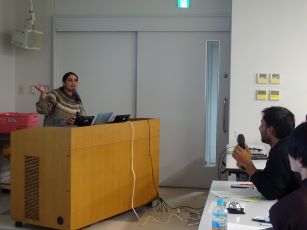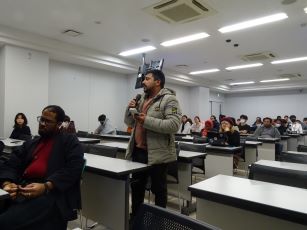- Home
- プログラム生/Ally生の活動報告
- 第8回 Student Monthly Progressを開催しました
第8回 Student Monthly Progressを開催しました
11月24日 (金)、第8回 Student Monthly Progressを開催しました。
4名の大学院生が自身の研究内容について発表を行いました。
【発表者】
1. BELLO Taiwo Kamar-deen:Laboratory of Theriogenology
<Effects of recombinant osteopontin (rOPN) and peptide 1 on endometrial epidermal growth factor (EGF) concentration and fertility in dairy cows>

2. NARONGPUN Pawarut:Division of Bioresources
<Whole-Genome Investigation of Zoonotic Transmission of Livestock Associated Methicillin-Resistant Staphylococcus aureus Clonal Complex 398 Isolated from Pigs and Humans in Thailand>

3. PANDEY SADAULA Gita:Laboratory of Parasitology
<Molecular detection and characterization of tick-borne hemoparasites in Rhinoceros unicornis (Greater One Horned Rhinoceros) of Nepal>

4. TAYA Yurie:Laboratory of Parasitology
<Exploring the eukaryotic microbiome in ticks.>

【座長】
RUBEL Md Zahir Uddin:Laboratory of Anatomy
MAEZONO Keisuke:Laboratory of Public Health

❖座長レポート❖
BELLO Taiwo Kamardeen’s research aimed to analyze the effects of recombinant OPN (rOPN) and peptide 1, an integrin binding motif of OPN, on the epidermal growth factor (EGF) normalization and fertility in postpartum cows. He examined endometrial EGF concentrations of 221 (rOPN =41; untreated =82; Peptide 1 =98) postpartum cows. All sampled cows were confirmed be healthy after screening and had resumed estrus by day 45-50 post-calving. He noted that the EGF normalization rate was higher in both the OPN and peptide 1 groups (78.3% and 53.1%, respectively) than in control group (25.6%). In addition, he found that conception rates of both treatment groups (46.3% and 46.9%, respectively) were higher than the untreated controls (28.0%). He concluded that rOPN and peptide 1 increased the EGF normalization rate by the time of artificial insemination (AI) and enhanced fertility in postpartum cows.
In his research, NARONGPUN Pawarut investigated the zoonotic transmission of livestock-associated methicillin-resistant Staphylococcus aureus clonal complex 398 (LA-MRSA 398) by using whole genome sequencing (WGS) technologies. He performed WGS on 16 representative samples of LA-MRSA CC9 and CC398, isolated from both pigs and workers, using Illumina Miseq platform. He found that the zoonotic transmission were caused by LA-MRSA CC398 in 2 farms. In addition, his WGS analyses revealed putative multi-resistant plasmids and several cross-resistance genes against drugs of last resort used in humans such as quinupristin/dalfopristin and linezolid. Finally, he emphasized that LA-MRSA isolates in his study harbored multiple virulence genes that may become a serious threat to immunosuppressed population, particularly those in close contact with LA-MRSA carriers.
PANDEY SADAULA Gita’s research objective is to investigate tick-borne pathogens of the genera Babesia, Theileria, and Hepatozoon as every year a number of one-horned rhinoceroses die in Nepal. She used thirty-six rescued one-horned rhinoceroses (Rhinoceros unicornis) as samples from two different locations in Nepal. She followed nested polymerase chain reaction (PCR) amplification of 18S rRNA technique for detecting Hemoparasites. Her research group confirmed that only Theileria bicornis protozoa was present in the blood sample. Among all samples 75% was positive and two previously unreported haplotypes (H5 and H6) they identified. They could not observe any significant association between infections and animal age, sex, or location. At last, she mentioned that the diagnosis of novel haplotypes and the high prevalence of Theileria has impacted the long-term viability of the rhino population and highlighted the importance of long-term wildlife health surveillance programs in Nepal.
The last presenter, TAYA Yurie's presentation was on exploring the eukaryotic microbiome in ticks, mainly focusing on the identification of Alveolata and fungi from ticks. The sample was collected from different prefectures of Japan. So, her research aim was to develop new methods to selectively amplify microeukaryote DNA by blocking the tick DNA amplification using blocker nucleic acids (PNA and LNA). She mentioned that the relative abundances of the eukaryotic microbes and the alpha diversity were estimated subsequently, and the differences of detected taxa among the methods were determined by linear discriminant analysis effect size (LEfSe) analysis. By following this method, she found that the detection rates of Alveolata and fungi were significantly abundant in both blocking PCR and 5 UNonMet-PCR, while those of other eukaryotes and unclassified sequences were significantly abundant only in blocking PCR. In conclusion, she indicated that the application of these methods improves our understanding of the tick microbiome.




